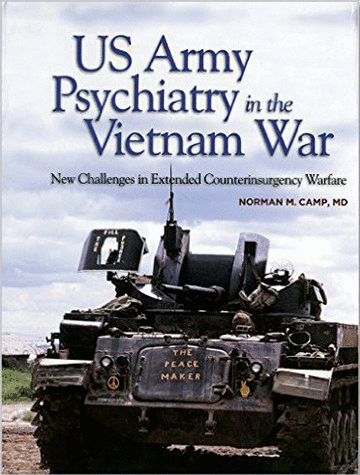U.S. Army Psychiatry in the Vietnam War: New Challenges in Extended Counterinsurgency Warfare
In U.S. Army Psychiatry in the Vietnam War: New Challenges in Extended Counterinsurgency Warfare, Col. Norman Camp, M.C., U.S. Army (Ret.) argues that the Vietnam War should really be viewed as two separate conflicts temporally demarcated by the 1968 Tet Offensive. Prior to this series of battles, American involvement in Vietnam involved purposeful combat missions with relatively high support for the war back in the United States, leading to fairly high morale and low rates of behavioral health casualties in spite of high combat exposure. Following the Tet Offensive, however, American support for the war both in the United States and in Vietnam decreased dramatically. The shift in combat focus from directly engaging the enemy to instead training the Vietnamese to fight for themselves also meant that the average soldier was often not meaningfully involved in any productive activity. As the war dragged on, psychiatrists were increasingly responsible for trying to control rampant heroin use, racial tension, and general unwillingness to fight. In addition, the psychiatrists themselves struggled with a lack of training in military psychiatry in the deployed setting and ambivalence about serving in Vietnam at all.

The civilian psychiatrist will find U.S. Army Psychiatry in the Vietnam War an interesting historical account of the war from a relatable perspective. One may be shocked by the seeming nonchalance some soldiers had around routine “fragging,” which involves soldiers murdering a member of their leadership who is perceived as overly rigid by throwing a fragmentary grenade into the individual’s office or sleeping quarters. Yet just as provocative may be the empathy the reader develops for early-career psychiatrists sent to Vietnam who had only five weeks of military training but were expected to manage the morale of tens of thousands of troops with little more than chlorpromazine and a typewriter.
For the modern military psychiatrist, Camp’s work should be mandatory reading. Lengthy accounts of the precise experiences of several individual psychiatrists in Vietnam may be too much detail for the average reader, but military psychiatrists who have deployed to Afghanistan in recent years will likely find that many of the same difficulties surrounding the support of stability operations in a counterinsurgency environment are identical between wars separated by more than 50 years and 3,000 miles. Dual-agency struggles, including an expectation to manage subclinical issues of morale and misconduct for a unit in spite of residency training predominantly focused on more severe mental illness, will be all too familiar. In fact, most modern military psychiatrists will be surprised by how little the overall structure of psychiatric care in the deployed setting has changed over half a century and may be left with a lingering desire for a similar volume about Operation Enduring Freedom, even if little more than the names and places will have changed from Camp’s work.
Where U.S. Army Psychiatry in the Vietnam War does struggle is in overall editing. While the occasional typo may be mildly distracting, in at least two places in the text a psychiatrist who is meant to be anonymized as “Dr. A” is overtly identified by name. Moreover, a more critical editing process could have easily shortened the volume by removing unnecessary repetition both within and between chapters. Yet aside from these errors, the work is overall well researched and brought to life by engaging photographs predominantly taken by Maj. Gen. Richard D. Cameron (Ret.).
History buffs looking for a unique exploration of the Vietnam War supported by impressive data and a multitude of firsthand accounts will find U.S. Army Psychiatry in the Vietnam War a fascinating view of a war they thought they knew. Meanwhile, military behavioral health professionals will find the education they wish they had received in residency—ironically the same education combat psychiatrists in the Vietnam War wished they had received as well.



